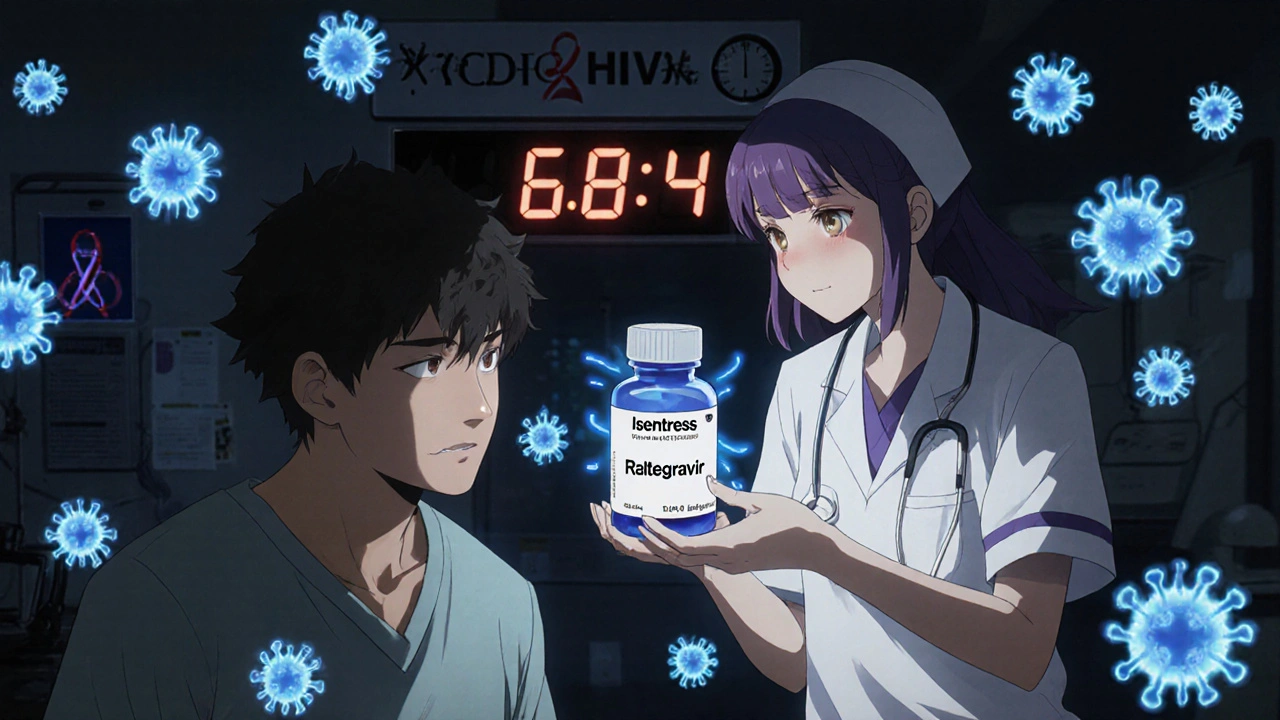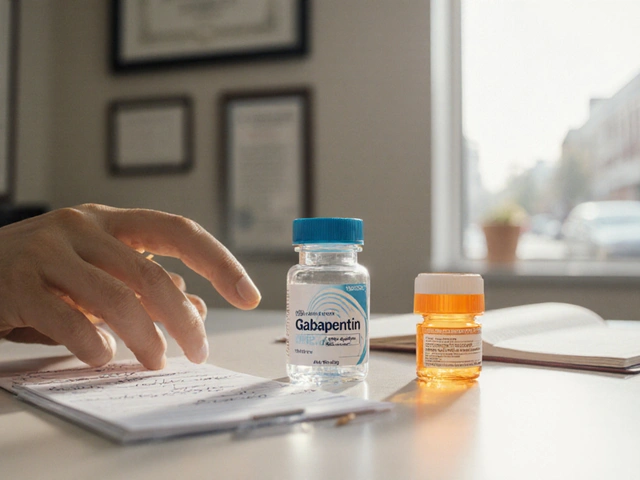When someone gets accidentally exposed to HIV-through a needlestick injury, unprotected sex, or sexual assault-the clock starts ticking. You have 72 hours to act. That’s the window for post-exposure prophylaxis, or PEP. For years, the go-to PEP regimen has been a three-drug combo: tenofovir, emtricitabine, and either raltegravir or dolutegravir. But with newer drugs hitting the market, people are asking: raltegravir still worth it? Or is it being phased out?
What Is Raltegravir and How Does It Work?
Raltegravir, sold under the brand name Isentress, is an integrase inhibitor. That means it blocks HIV from inserting its genetic code into human DNA. Without that step, the virus can’t replicate. It was one of the first drugs in its class approved by the FDA in 2007. Before raltegravir, PEP relied on older drugs like efavirenz and protease inhibitors, which had more side effects and harder dosing schedules. Raltegravir changed that. It was the first once-daily, well-tolerated integrase inhibitor for PEP. It’s not a cure. It’s a shield-something you take for 28 days after exposure to stop HIV from taking hold.
Why Was Raltegravir the Gold Standard for PEP?
Before 2018, raltegravir was the top pick for PEP in the U.S., Europe, and Australia. Why? Three reasons: speed, safety, and simplicity. It starts working fast-peak levels hit the bloodstream within 2-4 hours. It’s gentle on the stomach. Most people don’t get nausea or dizziness. And unlike older regimens that required four pills a day, raltegravir came in a single tablet, taken twice daily. That made adherence easier. A 2016 study in the Journal of Acquired Immune Deficiency Syndromes tracked over 1,200 people on raltegravir-based PEP. Only 7% stopped early because of side effects. Compare that to efavirenz-based regimens, where up to 30% quit due to nightmares or dizziness.
What Changed? Enter Dolutegravir
In 2018, guidelines started shifting. Dolutegravir, another integrase inhibitor, showed up with better data. It’s just as effective as raltegravir but can be taken once a day. That’s a big deal when you’re already stressed after a potential exposure. Taking one pill instead of two makes it easier to stick with the full 28-day course. A 2020 randomized trial in South Africa compared dolutegravir and raltegravir for PEP. Both prevented HIV infection in over 98% of cases. But people on dolutegravir were 40% more likely to finish their course. That’s not a small difference. Missing even a few doses can lower your protection.
Is Raltegravir Still Used Today?
Yes-but less often. In New Zealand, Canada, and the UK, dolutegravir is now the first-line choice for PEP. Raltegravir is still on the list, but mostly as a backup. If someone can’t take dolutegravir-because they’re pregnant, have a known allergy, or are on certain anticonvulsants-then raltegravir becomes the alternative. It’s also used in cases where HIV resistance testing shows the strain might be resistant to dolutegravir. That’s rare, but it happens. In the U.S., the CDC still lists raltegravir as an option, but recommends dolutegravir over it. Hospitals in Wellington and Auckland now stock dolutegravir as standard. Raltegravir is kept in reserve.

Who Might Still Get Raltegravir?
Not everyone gets the same PEP regimen. Here are three real cases where raltegravir still makes sense:
- A 34-year-old nurse who had a needlestick from a patient with known HIV resistance to dolutegravir. Her clinic switched her to raltegravir after genotyping confirmed the strain.
- A pregnant woman at 12 weeks who can’t take dolutegravir due to limited safety data in early pregnancy (though newer studies suggest it’s likely safe, guidelines remain cautious).
- A person with severe kidney disease who can’t take tenofovir-based drugs. Raltegravir doesn’t need kidney adjustment, so it’s the only integrase inhibitor that fits.
In these cases, raltegravir isn’t the first choice-it’s the right choice. And that matters.
Side Effects and Tolerability
Raltegravir is generally well-tolerated. The most common side effects are mild: headache, trouble sleeping, and occasional diarrhea. Less than 1% of users develop a serious rash or liver problem. That’s lower than the 5% rate seen with older drugs like efavirenz. But here’s something people don’t talk about enough: raltegravir can cause muscle pain or elevated creatine kinase. In rare cases, that leads to rhabdomyolysis-a condition where muscle breaks down and can damage kidneys. It’s extremely rare, but if you’re on raltegravir and feel sudden, unexplained muscle weakness or dark urine, you need to get checked right away.
Cost and Access
In New Zealand, PEP is free through public hospitals. But the cost of the drugs varies. Dolutegravir is now cheaper than raltegravir because it’s off-patent and widely generic. Raltegravir is still under patent protection in some countries, so its generic version isn’t as widely available. That means even if raltegravir works just as well, hospitals and clinics often choose the lower-cost option. Insurance companies in the U.S. and Australia now require prior authorization for raltegravir, pushing doctors toward dolutegravir first.

What Does the Evidence Say Today?
A 2024 meta-analysis in The Lancet HIV looked at 17 studies involving over 5,000 PEP users. The conclusion? Both raltegravir and dolutegravir prevent HIV infection with near-identical success rates-98.2% vs. 98.5%. But dolutegravir had better adherence and fewer drug interactions. For most people, the difference is negligible. But for those who struggle with daily routines, or who have other health conditions, the once-daily dosing of dolutegravir gives it a real edge.
When Should You Ask for Raltegravir?
You don’t need to request a specific drug. Your doctor will choose based on your health, exposure type, and local guidelines. But if you’ve had a high-risk exposure and you’re told you’ll get dolutegravir, ask: “Is there a reason I can’t take raltegravir?” If you’ve had side effects from other HIV drugs in the past, or if you’re pregnant, that’s your chance to bring up alternatives. Don’t assume the first option is the only one. PEP is time-sensitive. If you’re unsure, go to an emergency department. They can start you on PEP within an hour-even if you’re not sure you need it.
Final Thoughts: Is Raltegravir Still Viable?
Yes. But not as the first choice. Raltegravir is still a powerful, reliable tool. It saved lives before dolutegravir existed. It still does today-for people who can’t use newer drugs. But for the average person after a single exposure, dolutegravir is simpler, cheaper, and just as effective. Raltegravir isn’t outdated. It’s specialized. Think of it like a backup generator: you hope you never need it, but you’re glad it’s there when you do.
Can raltegravir be used for PEP in pregnancy?
Yes. Raltegravir is considered safe during pregnancy and is often preferred over dolutegravir in the first trimester, due to slightly more established safety data. While newer studies suggest dolutegravir is also safe, many clinics still use raltegravir for pregnant people in early pregnancy as a precaution. Always consult with an HIV specialist if you’re pregnant and need PEP.
How soon after exposure should raltegravir be started?
The sooner, the better. Raltegravir works best if started within 2 hours of exposure, but it’s still effective up to 72 hours. After 72 hours, PEP is no longer recommended because the virus has likely already established infection. Don’t wait to see if you feel sick-start immediately if you’ve had a high-risk exposure.
Does raltegravir cause weight gain?
Unlike some newer HIV drugs, raltegravir is not strongly linked to weight gain. Studies show minimal changes in body weight during PEP use. This makes it a good option for people concerned about metabolic side effects. Long-term use in treatment regimens may show slight weight increases, but during the 28-day PEP course, weight gain is not a common concern.
Can I take raltegravir with other medications?
Raltegravir has fewer drug interactions than older HIV drugs, but it can interact with antacids, some seizure medications (like carbamazepine), and rifampin (used for tuberculosis). Always tell your doctor what else you’re taking. Antacids should be taken at least 2 hours before or after raltegravir to avoid reducing its absorption.
What happens if I miss a dose of raltegravir?
If you miss a dose by less than 6 hours, take it as soon as you remember. If it’s been more than 6 hours, skip the missed dose and take your next one at the regular time. Never double up. Missing one dose is unlikely to fail PEP, but missing several increases risk. Stick to your schedule as closely as possible-adherence is the biggest factor in success.
If you’ve had a potential HIV exposure, don’t wait. Go to your nearest emergency department or sexual health clinic. PEP works. And whether it’s raltegravir or dolutegravir, getting started fast is what matters most.







Write a comment
Your email address will be restricted to us